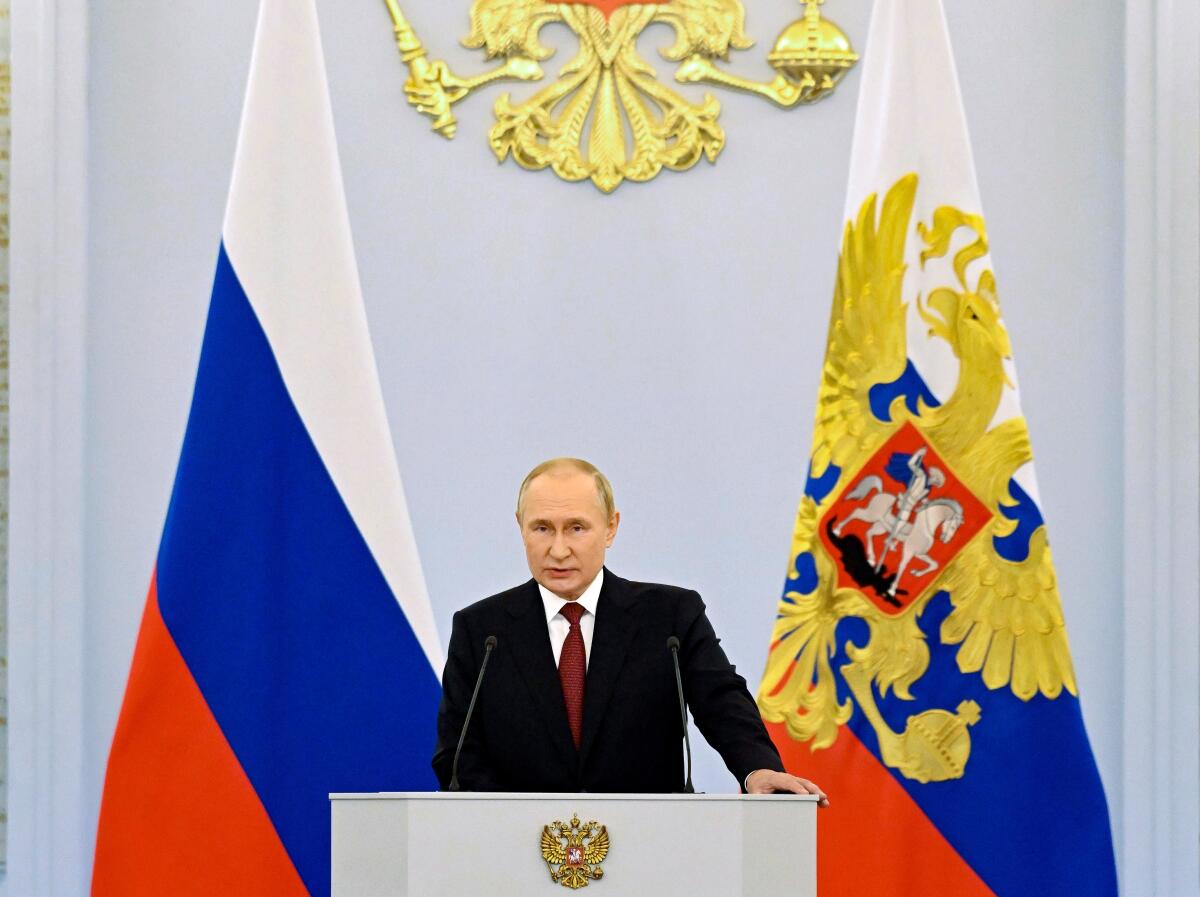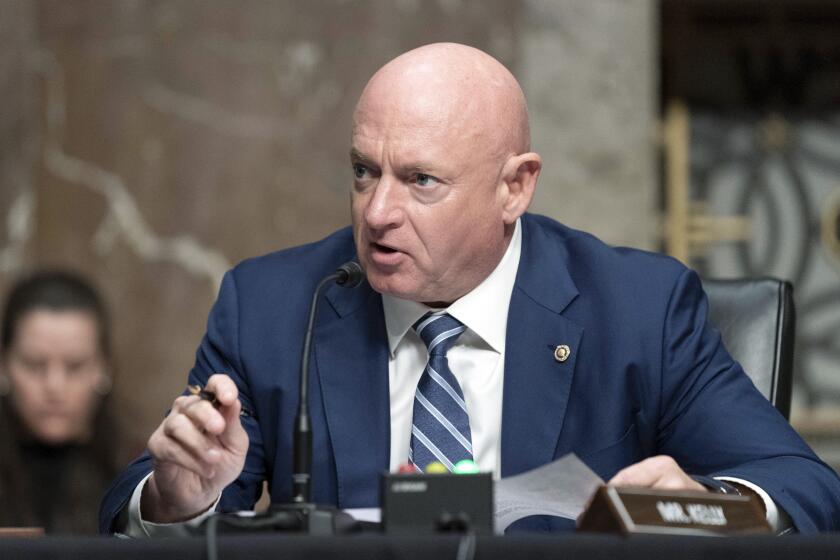Column: Putin’s threat of a nuclear strike on Ukraine may not be a bluff. What do we do now?

- Share via
WASHINGTON — After weeks of reverses, Russia’s army is still losing ground in the battlefields of Ukraine.
President Vladimir Putin’s response, characteristically, has been to escalate on other fronts.
Putin expanded the military draft, announcing a call-up of 300,000 reservists and prompting an exodus of Russian men to neighboring countries.
The midterm election battleground has narrowed as some races move out of contention. Control of the Senate remains uncertain.
On Friday, he formally announced Russia’s annexation of four Ukrainian provinces, turning them — at least rhetorically — into Russian territory that he can never negotiate away.
Most chilling, Putin renewed threats that he is ready to use nuclear weapons if Ukraine’s troops try to take those provinces back.
“In the event of a threat to the territorial integrity of our country … we will certainly make use of all weapon systems available to us,” he said. “This is not a bluff.”
On that count, Putin may be telling the truth.
“It isn’t a bluff,” Fiona Hill, who served on the National Security Council staff under President Trump, told me. “He’s losing on the battlefield, so he’s trying to intimidate Ukraine and the West into giving up.”
“If Putin faces the imminent prospect of losing the war, he’s likely to use nuclear weapons before being defeated,” warned Matthew Kroenig of the Atlantic Council, a former Pentagon strategist. “This is probably the closest we’ve come to nuclear use since at least the 1980s.”
The weapons Putin is brandishing aren’t the massive long-range missiles aimed at the United States in the Cold War balance of terror. The targets wouldn’t be New York or Washington; that kind of strike would provoke an immediate U.S. nuclear response.
Instead, he’s threatening to use some of the estimated 2,000 “tactical nuclear weapons” that Russia has stockpiled for battlefield use — smaller warheads, but potentially devastating. Some of those “low-yield” nukes are as powerful as the bomb the United States dropped on the Japanese city of Hiroshima in 1945, killing at least 70,000. Some are larger.
Strategists suggest that Putin may be considering several options: He could detonate a “demonstration shot” over the Black Sea or a remote rural area to grab the world’s attention.
More likely, he could target large concentrations of Ukrainian troops in hopes of changing the military momentum on the ground.
Or he could attack Ukraine’s capital, Kyiv, in an attempt to decapitate the Ukrainian government — an act that could also kill tens of thousands of civilians.
In each case, his larger goal would presumably be the same: to shock Ukrainians, Europeans and Americans into standing down from the war and accepting his territorial demands.
To which the U.S. response has been straightforward: It won’t work.
“Any use of nuclear weapons will be met with catastrophic consequences for Russia,” Jake Sullivan, President Biden’s national security advisor, said last week. “The United States will respond decisively … and we will continue to support Ukraine in its efforts to defend its country.”
Sullivan refused to spell out publicly what those “catastrophic consequences” might be.
But other officials have long made an important point: The U.S. response to a Russian nuclear strike in Ukraine need not be nuclear in return.
Conventional strikes against Russian military targets using long-range missiles with precision-guided warheads could have equal military impact with fewer negative side effects.
U.S. or Ukrainian forces could use U.S.-supplied missiles to destroy the Russian bases that launched the nuclear attack, sink Russia’s Black Sea fleet or both.
A nonnuclear response could have several advantages. It would avoid putting the United States and Russia on a Cold War-style ladder of nuclear escalation. It could avoid allowing Putin to paint his war in Ukraine as a struggle against the North Atlantic Treaty Organization. And it could help the U.S. and its allies rally global opposition to Russia as the only country to break the post-World War II taboo against the use of nuclear weapons.
It could also help the Biden administration preserve two goals that have sometimes been in tension: supplying Ukraine with enough weapons to defeat Russia’s invasion while seeking to avoid — or at least limit — direct combat between Russia and NATO.
“We are doing everything we can to help the Ukrainians to defend themselves,” Secretary of State Antony J. Blinken said last week. “We’re also determined that this war not expand.”
Or, as Biden has put it more bluntly, “We’re trying to avoid World War III.”
A Russian nuclear strike on Ukraine would inevitably bring World War III a step closer. The challenge for Biden is to persuade Putin that such an attack would be a losing proposition — and, if deterrence fails, to keep the conflict that follows from spiraling out of control.
More to Read
Get the L.A. Times Politics newsletter
Deeply reported insights into legislation, politics and policy from Sacramento, Washington and beyond. In your inbox three times per week.
You may occasionally receive promotional content from the Los Angeles Times.












